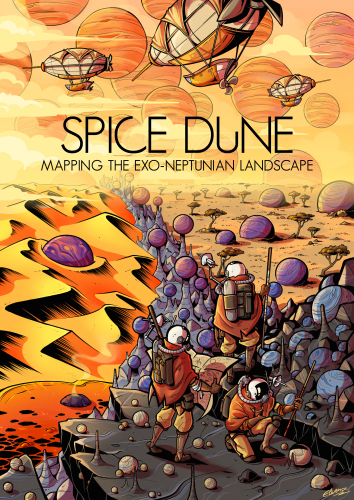The ATREIDES program in search of lost exo-Neptunes

An international scientific team led by the University of Geneva (UNIGE), including members of the UNIGE Astronomy Department, the National Centre of Competence in Research PlanetS, the University of Warwick, and the Instituto de Astrofísica de Canarias, has launched an ambitious program to map exoplanets located around the Neptunian Desert in order to better understand the mechanisms of planetary system evolution and formation. This scientific expedition has delivered its first results with the observation of the TOI-421 planetary system. Analysis of this system reveals a surprisingly inclined orbital architecture, offering new insights into the chaotic history of these distant worlds. The study, which marks the beginning of the ATREIDES collaboration, is published in the journal Astronomy & Astrophysics.
What are the physical mechanisms that govern the formation and evolution of planetary systems? To answer this broad question, a group of scientists led by the UNIGE Department of Astronomy decided to focus on one type of exoplanet: exo-Neptunes. These planets, which are the size of Neptune and 17 times the mass of Earth, are linked to several peculiarities in the exoplanet population, notably the Neptunian Desert.
By observing the orbits close to stars, scientists have discovered very few planets of intermediate mass (that of Neptune), while they have observed an abundance of more massive planets (such as Jupiter) or less massive planets (only a few Earth masses). It is this absence of Neptune-mass planets that astronomers have called the Neptunian Desert.
Recently, international teams, including members of UNIGE, have also been able to highlight two additional features in the distribution of Neptunes: a more temperate zone—where planets are slightly further from their star than in the Desert—called the Savanna, where Neptunes are more common than in the Desert, and an area of overdensity between the Savanna and the Desert called the Neptunian Ridge. These specific characteristics of the Neptune population provide astronomers with an ideal playground for understanding the history of planetary systems.
“The complexity of the exo-Neptunian landscape provides a real window onto the processes involved in the formation and evolution of planetary systems. This is what motivated an ambitious scientific collaboration, ATREIDES, which is based in particular on a large-scale observation program that we are conducting using the largest European telescopes, the ESO’s VLTs with the world’s most accurate spectrograph, ESPRESSO,” explains Vincent Bourrier, Senior Lecturer and Researcher in the Astronomy Department of the Faculty of Science at UNIGE, principal investigator of the ATREIDES program and lead author of the study published today in the journal Astronomy & Astrophysics.
ATREIDES – Conquering the Desert
The ATREIDES program focuses on exo-Neptunes in order to identify the processes responsible for the Neptunian’s Ridge, Savanna, and Desert, and to deduce more general information about the evolution and formation of planets. To do this, scientists plan to observe a large number of Neptunes with ESPRESSO and analyze and model data from all planets in a comprehensive, consistent, and coherent framework. This systematic approach should enable a real comparison between different planetary systems and a better understanding of the mechanisms that shape this complex Neptunian landscape.
Designed as an open, international community initiative, the ATREIDES collaboration invites all interested astronomers to join the scientific effort around these Neptunes, following the example of the University of Warwick, which is contributing with its NGTS telescopes, an exoplanet observation program using the transit method—when a planet passes in front of its star—of which UNIGE is also a partner.
“We use NGTS to observe the transit of these Neptunes and thus optimize our use of ESPRESSO/VLT. We can then obtain much more accurate measurements or identify processes, such as stellar eruptions, that could influence the ESPRESSO data,” explains Daniel Bayliss, Associate Professor in the Department of Physics at the University of Warwick.
A first pinch of spice: Orbital Architecture of TOI-421.
The first system observed and analyzed as part of ATREIDES is called TOI-421. It has two planets, a warm Neptune TOI-421 c located in the Savanna and a smaller planet closer to the star, TOI-421 b. Astronomers have been able to trace the chaotic history of this system.
One of the hypotheses that the ATREIDES program aims to address is that the Neptunian landscape was sculpted by the way these planets migrated from their birthplace to their current orbits. Some planets migrate slowly and early through the gas disk in which they formed, a process that should produce aligned orbits. Others are violently propelled into their orbits much later through a chaotic process called high-eccentricity migration, which results in highly misaligned orbits.
One of the key variables in this hypothesis is therefore the alignment between the star’s equatorial plane and the orbital plane of each planet. For TOI-421, the two planets in the system are highly misaligned, which is very different from our solar system where the planets are aligned and therefore rotate almost in the equatorial plane of our Sun. This points to a turbulent history in the evolution of the TOI-421 system after its formation.
The Spice must flow.
The analysis of TOI-421 is just a taste of what is to come. It provides scientists with valuable information, but above all, it allows them to refine the analysis and modeling tools developed in the ATREIDES collaboration. However, a large number of planetary systems with exo-Neptunes will need to be observed and analyzed with the same rigor as this one before we can outline the evolution and formation of planetary systems.
“A thorough understanding of the mechanisms that shape the Neptunian Desert, the Savanna, and the Ridge will provide a better understanding of planetary formation as a whole…but it’s a safe bet that the universe has other surprises in store for us that will force us to develop new theories,” concludes Vincent Bourrier, with a few blue reflections in his eyes.
Publication : https://www.aanda.org/10.1051/0004-6361/202554856
Categories: News


